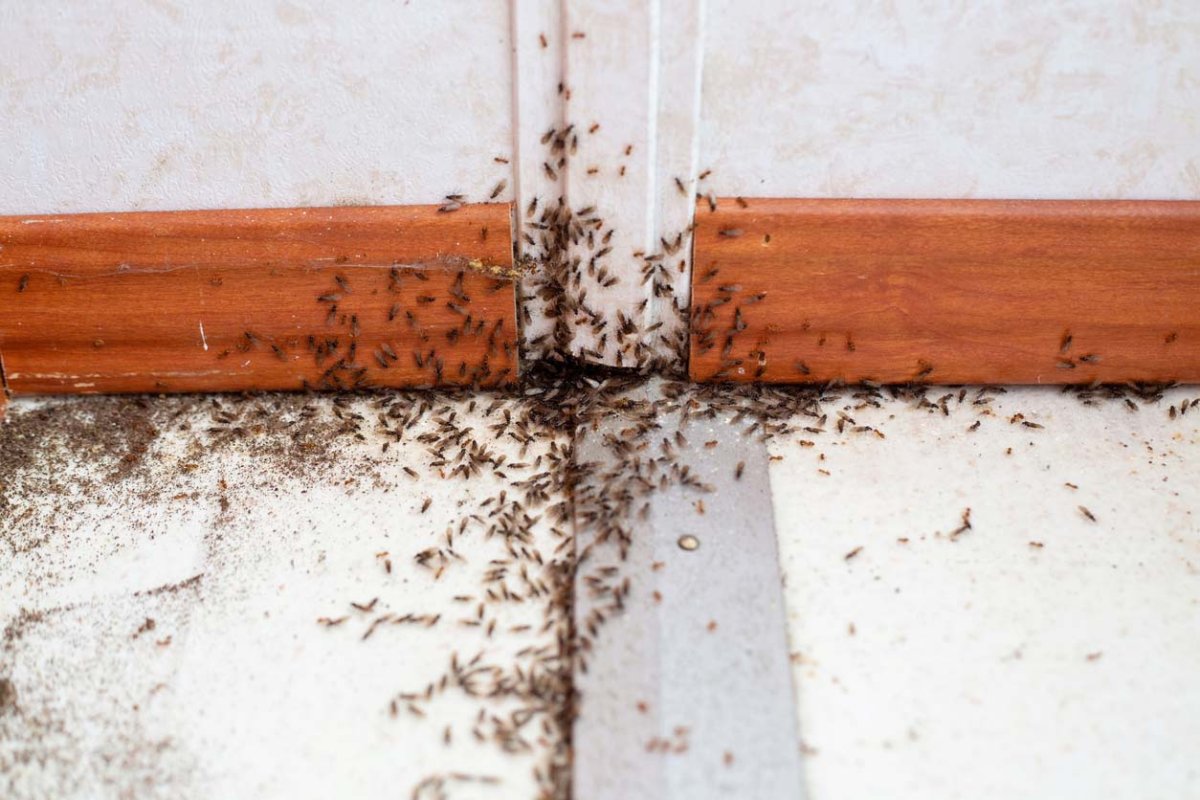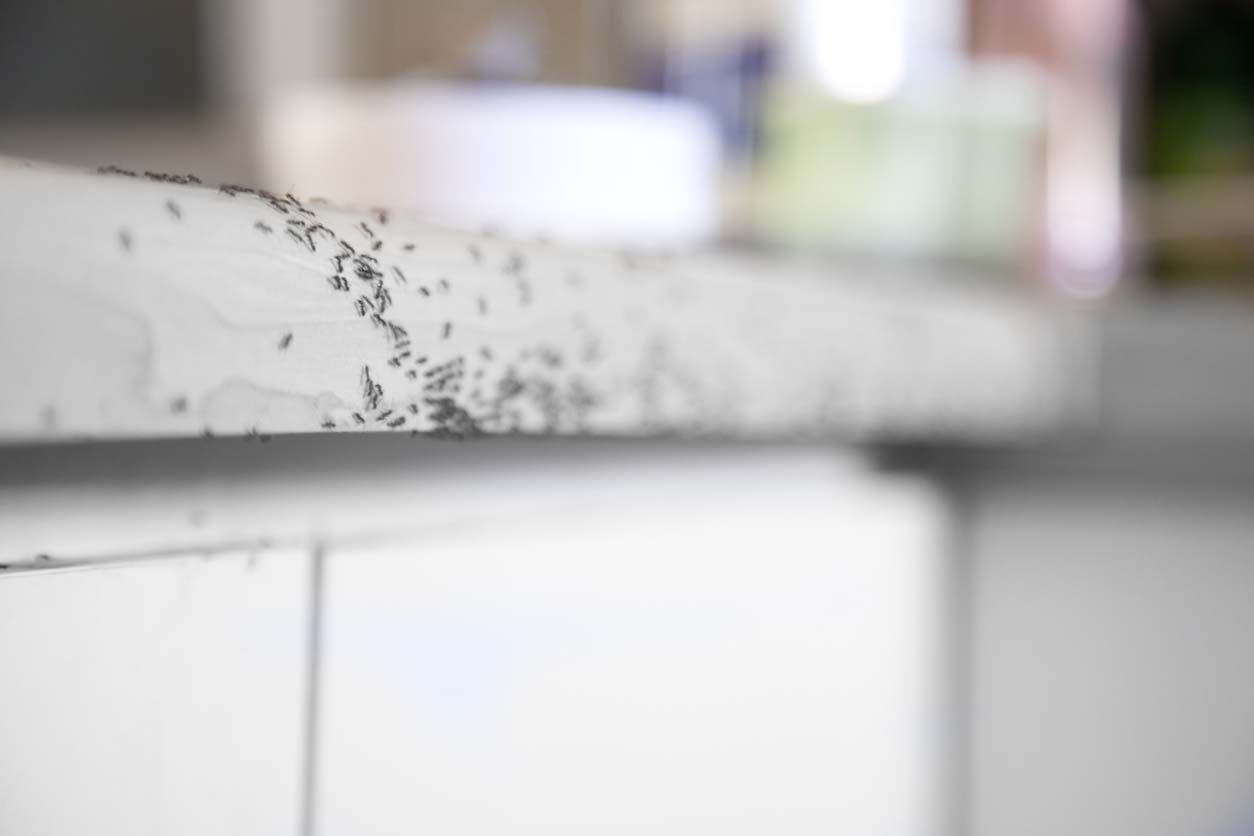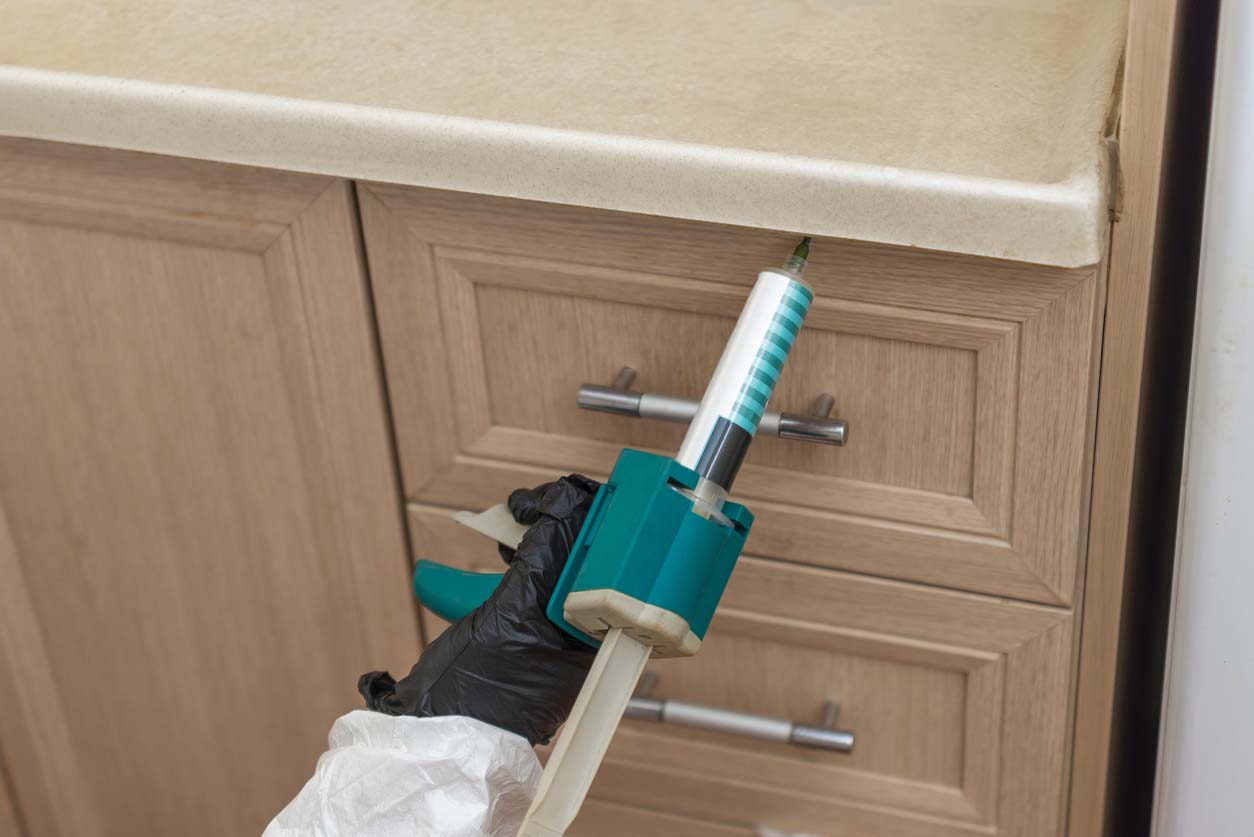

We may earn revenue from the products available on this page and participate in affiliate programs. Learn More ›
What You Need to Know
- There are several options when it comes to little black bugs in your kitchen, but the most common culprits are moths, beetles, mites, weevils, fruit flies, drain flies, and ants.
- Homeowners can prevent bug infestations by sealing food containers, keeping the kitchen clean, and controlling the moisture level in the air.
- Small bug infestations can be addressed by a homeowner using some items they probably already have in their home.
- For larger or more persistent infestations, hiring a pest control professional is the best path forward.
Q: Lately, I’ve noticed little black bugs in my kitchen, and they won’t go away. How do I get rid of them? Do I need to call pest control, or is this something I can handle on my own?
A: From pantry bugs to tiny brown ants on your kitchen counter, little black bugs in the kitchen are no small matter. After performing kitchen bugs identification, it’s time to get rid of them from your home. If you need to know how to get rid of bugs in your house, the guide below can help identify what type of bug is present and how to eradicate the bugs and keep them from returning. Getting rid of the pesky insects may require inspecting and then cleaning the areas they frequent, followed by DIY or professional treatment from one of the best pest control companies (such as Orkin or Terminix).
| Insect | Color | Food Source | Area of Infestation |
| Moth | Brown | Dry food, grains | Pantry, cupboard |
| Grain Mite | Brown | Dry food, grains | Pantry, cupboard |
| Weevil | Brown | Dry food, grains | Pantry, cupboard |
| Beetle | Brown, black | Grains, fibers | Pantry, closet, carpet |
| Fruit fly | Black | Decomposing fruits and vegetables, sugary liquid | Kitchen |
| Black ant | Black | Organic matter | Kitchen, windows, doors |
| Cockroach nymph | Brown | Crumbs, grease, organic matter | Kitchen, under sinks |
| Drain fly | Black | Decomposing organic matter | Sink drains, disposals |
| Silverfish | Silver, gray | Organic matter, paper products | Humid, wet spaces |
Moths, beetles, grain mites, and weevils are commonly found around food storage.
Dry goods serve as the main food source for moths, beetles, grain mites, and weevils. If there is evidence of these bugs in the cabinets or pantry, which can range from webbing to cocoons or live insects, it’s necessary to sort through dry pantry goods to ensure the problem doesn’t run deeper. If there’s any evidence of insects in a container, the contents will need to be thrown out. If the container is reusable, it’s important to clean it thoroughly before using it again.
It’s possible to get rid of moths, beetles, grain mites, or weevils by cleaning the shelves, cupboards, or pantry spaces to remove any debris or crumbs that could be inviting these insects in. It also helps to keep the pantry or food storage areas nice and cool, since grain beetles and moths typically thrive in warm conditions. Keeping dry goods securely stored in sealed plastic or glass containers can also prevent bugs in flour and other pantry goods.

Carpet beetles typically eat textiles, but they’ll also feed on dry pantry goods.
Although they don’t pose a threat to human health, carpet beetles can become a nuisance if they infest carpet, clothing, or food storage. These bugs are small, oval-shaped insects that typically measure 1/16 to 1/8 inch in length. They mostly feed on natural fibers such as wool, fur, feathers, and silk, which is why they’re called carpet beetles. However, they can also consume food products such as cereal and spices.
Signs of carpet beetles include irregular-shaped holes in carpet, rugs, clothing, or upholstery. Shed skin or fecal pellets may also be present in cabinets or pantries. If these signs are present, it’s possible to get rid of the small black bugs by cleaning and maintaining the home on a regular basis. Frequent vacuuming, as well as storing clothing and food in airtight containers, can help remove any eggs, larvae, or adult beetles hanging around.
Fruit flies seek out sweet smells such as ripe or overripe fruit.
A kitchen may be attracting bugs due to easy access to food sources. Fruit flies are among the many black bugs with wings that tend to hover around fruit, vegetables, and other organic matter found in the heart of the home. If there are small bugs in the kitchen that are tan to light brown and about 1/8 inch long, they could be pesky fruit flies. These little bugs in the kitchen feed off fresh or decaying fruit and vegetables, so it’s best to store these foods in a cabinet or refrigerator where the bugs don’t have open access to them. Sugary substances such as juice, soda, and alcoholic beverages are also attractive to fruit flies.
It’s possible to treat fruit flies with insecticides, fly traps, or baits, and once the current flies are gone, reinfestation can be prevented by removing any decomposing fruits and vegetables and cleaning up spills from beverages or food debris as soon as the tiny black bugs in the house are noticed.

Black ants live in colonies, and an infestation of these bugs can grow quickly.
Ants in the kitchen, even though they’re common kitchen bugs, are no small problem. They can quickly multiply once they gain access to the inside of a home and come in contact with morsels that can add to their food and water supply. Black ants enter a space through cracks in doors, windows, or floors. And once they’re in, their queen will continue to send more ants that way, which is why killing only a few isn’t an effective control method.
Instead, it’s necessary to kill off the ant colony where the queen lives to ensure the tiny black bugs in a kitchen are gone for good. This can be achieved by tracking the ants back to their nest and putting pepper, vinegar, boiling water, or diatomaceous earth on the nest to destroy it. You can also try putting ant baits near the infestation. Ant baits encourage the ants to consume a harmful liquid that they bring back to their colony, which ultimately kills the entire colony.
Cockroach nymphs and drain flies can often be found by sinks and garbage disposals.
Like their name suggests, drain flies are black, small insects drawn to organic matter in moist environments such as household drains or garbage disposals. They’re even more likely to infest areas near plumbing leaks or drains that aren’t well maintained. These insects have hairy wings that make them resemble small black moths, though they are usually gray or brown in color. The best way to get rid of drain flies is to ensure that drains and garbage disposals are clean, either by using one of the best drain cleaners or hiring one of the best drain cleaning services.
Cockroach nymphs, which are smaller, wingless versions of adult cockroaches, also feed off decomposing organic matter found near sinks and garbage disposals. If you spot small, tiny brown bugs in the house in warm, wet environments such as underneath bathroom or kitchen sinks, you may have a roach infestation on your hands. Baits, traps, or insecticides may be able to handle a few cockroaches, but evidence of multiple bugs can mean there’s a more serious issue. Professional pest control companies are best equipped to handle stubborn cockroach infestations.
After treatment, both drain flies and cockroach nymph infestations can be prevented by cleaning up crumbs or other messes as well as sealing access points and eliminating clutter that can serve as a hiding place.
Silverfish are drawn to areas of high humidity.
Silverfish are typically easy to tell apart from other bugs since they are silver or gray in color and have scales that cover their elongated bodies. At about 1/2 to 1 inch long, silverfish prefer dark, damp spaces with high humidity levels, such as basements, bathrooms, attics, laundry rooms, and kitchens. They’re more likely to be spotted at night since they’re nocturnal insects, so they spend the majority of the daytime hiding in cracks or crevices. These bugs feed on starchy material found in paper, books, cardboard, and fabric. The best way to get rid of silverfish is to control the humidity levels in the home through dehumidifiers or improving ventilation. Removing food sources and cleaning dark spaces as often as possible can help eliminate the wriggling bugs.
Keeping the kitchen clean, sealing pantry goods, and controlling moisture can keep pests from invading the kitchen.
The not-so-secret way to get rid of small black bugs in the house and kitchen is to eliminate their food source. Since a lot of small bugs enter a home looking for crumbs, organic matter, decomposing fruits or vegetables, or paper products, regularly cleaning up and properly storing fruit and vegetables can help reduce a population of small bugs in houses.

Many people already have already have products at home to help deal with bugs in the kitchen.
You may not necessarily need to take a trip to the home improvement store to deter tiny black bugs in a bathroom or kitchen. There’s a good chance you already have some of the ingredients below, all of which can help keep bugs at bay.
- Borax: Mix borax with sugar and spread it in areas where cockroaches have been spotted to kill them off.
- Baking soda: Baking soda sprinkled near ant entrances can keep them out.
- Garlic: The smell of fresh garlic or garlic powder can deter most bugs.
- Peppermint oil: A few drops of peppermint oil mixed with water can be sprayed in areas bugs frequent to keep them away.
- Neem oil: This natural oil disrupts the feeding and reproductive cycle of bugs, so you can mix some with water and spray it where bugs are present.
- Diatomaceous earth: A natural insecticide, diatomaceous earth can be spread in entry points, on baseboards, under appliances, or along the paths of pests to kill small-bodied insects.
- Insect traps: Sticky traps, funnel traps, and light traps can be placed around the home to lure insects in and kill them.
- Bay leaves: A few bay leaves placed in a pantry or closet spaces can deter everything from beetles to moths to weevils.
If kitchen pests are proving to be difficult to get rid of, it’s best to call an experienced pest control professional.
Whether you’re dealing with small tiny bugs in the house or tiny black flying bugs around the sink, DIY methods might not cut it. In those cases, it may be worth it to contact one of the best pest control companies to take a look at your home and come up with a treatment plan. Not only can these experts perform an official inspection, but they can also provide an estimate for how much treatment will cost, especially for those who need multiple treatments applied. They’ll also know exactly which type of small black bugs are present and exactly how to get rid of them. Plus, professionals will have the latest equipment and solutions to target pests and eliminate the problem quickly.
